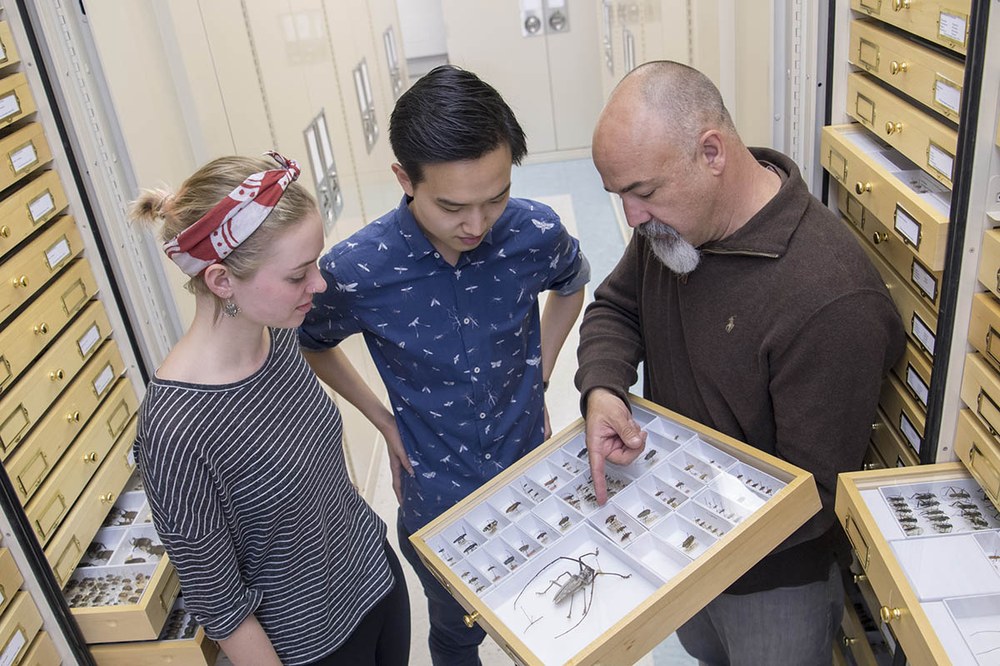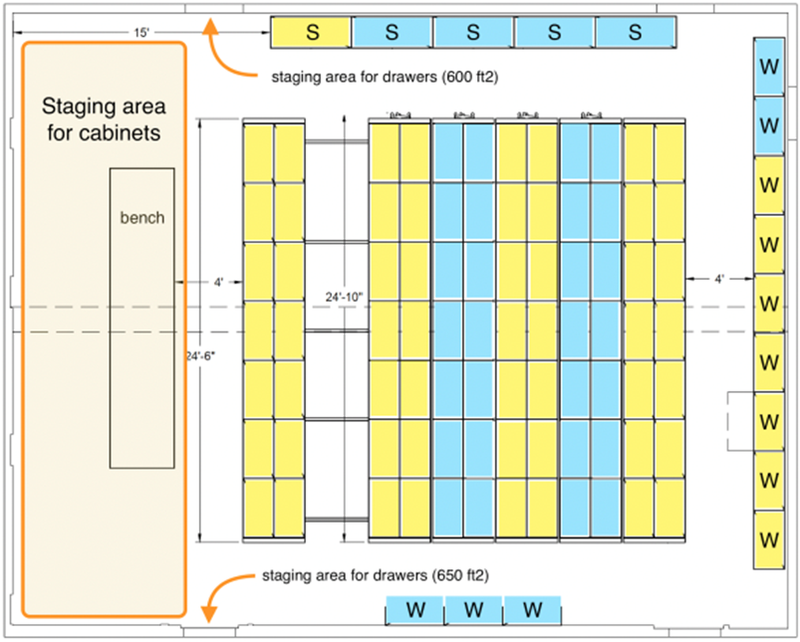Posted: April 5, 2021
IBC Fellow and Entomology graduate student Codey Mathis interviews Dr. Andy Deans regarding plans to expand Frost Museum storage capabilities

Studying an exhibit case in the Frost Entomological Museum
For over 50 years, the Frost Entomological Museum has been an invaluable resource for the Department of Entomology here at Penn State. The museum has the third largest insect collection in Pennsylvania, with an estimated 1.3 million specimens from around the world dating back to 1853. The insect collections housed at the Frost include some of the most diverse collections of sucking lice, aphids, and dragonflies. Many recent research projects by Penn State entomologists have added many bees and wasps to the collection. While the Frost draws in over 1,000 visitors from the public every year, collaboration with other institutions through requests for data, requests for loaned specimens, and visiting scholars also underscore the importance of this institution. But while the Frost is obviously an important cornerstone to the Department of Entomology, it has run into a problem: it’s running out of space.
“When I started here, we were something like 97% full; I think we only counted 8 empty drawers in the entire collection,” says Dr. Andy Deans, a Professor in Entomology and Director/Curator of the Frost Entomological Museum. Dr. Deans started his role of curator when he joined Penn State in May 2012. “Every drawer where we had specimens in jars or vials of ethanol was filled. We were at capacity.” Soon after joining Penn State, Dr. Deans recognized this problem and wrote a grant proposal to NSF in 2014 to upgrade from the old, disorganized storage system to a sleek and upgraded system with more storage (Figure 1). “At that time, we had 1,700 drawers and we added space for 800 more. We’ve since filled that because we have so many ongoing projects, not only in my own lab, but the Department has hired more systematists (Drs. Margarita López-Uribe, Tanya Renner, Julie Urban, and Michael Skvarla). We have a bigger community of professionals that use these resources. We really need to grow much faster and grow our space more quickly than anticipated.”

Figure 1. (a-c) The collection room, a “cluttered morass” prior to renovation and storage upgrade. (d-e) A clean and more organized collection room after funding from NSF. Images used with permission of Andy Deans.
In part, the growing need for another storage expansion was spurred by the creation of the Insect Biodiversity Center, which will undoubtedly inspire projects that will curate more insects that need to be managed by the Frost. By preserving these insects, their legacy can live on for longer than the one project they were initially collected for. “That was our justification for going back to NSF. They prefer to invest in institutions that are supporting collections, and Penn State is obviously growing their capacity for insect biodiversity research.”
The new proposal, which was recently awarded $391,298 in funding from NSF, was written by Dr. Deans, Dr. Michael Skvarla, and the Frost’s collection manager, Laura Porturas. “Normally, it takes 2 or 3 resubmissions to get one of these grants, but we got it on the first try,” says Dr. Deans, speaking of the competitive nature of NSF grants. “I think that’s a testament to the level of research activity and research quality here at Penn State.” The money will go towards increasing specimen storage and digitizing (photographing and labeling) specimens. Updating the cabinets with a high-density compactor storage system will allow extra space for new rows and add 1,600 drawers of expanded space (Figure 2). Digitizing the slide-mounted aphid collection (~224,000 specimens) and the aquatic insect collection (~100,000 specimens) allows them to be shared on public repositories, like the Global Biodiversity Information Facility (GBIF). The aquatic insect collection hosts specimens that serve as important biological indicators of the water quality in the streams they were collected from. “Pennsylvania is a hotspot for aquatic insect diversity”, says Dr. Deans. “Ours might not be a huge collection, but it’s an important one, and it represents a diverse part of the country.” There’s already interest within the Department for research with the improved aphid collection. “We are incredibly lucky to have Dr. Skvarla because not only did he do his post-doctoral work on aphids, but he’s interested in continuing research on aphids, so having him here is the perfect storm,” says Dr. Deans. “We have someone here that is very interested in these specimens and wants to do research with them, so this is the right time to improve that collection.”

Figure 2. Frost Entomological Museum collection room expansion. Yellow = existing storage. Blue = proposed expansion in storage. Orange = staging areas during compactor installation. S = slide storage for aphids. W = wet specimen storage. Image used with permission of Andy Deans.
While the Frost Museum is currently closed to visitors due to COVID-19, Dr. Deans is looking forward to reopening the space to the public when it is safe to do so. You can follow Frost Museum updates and expansion progress by visiting the Frost Curators’ Blog or subscribing to the Frost Entomological Museum’s newsletter.
Contact Information


